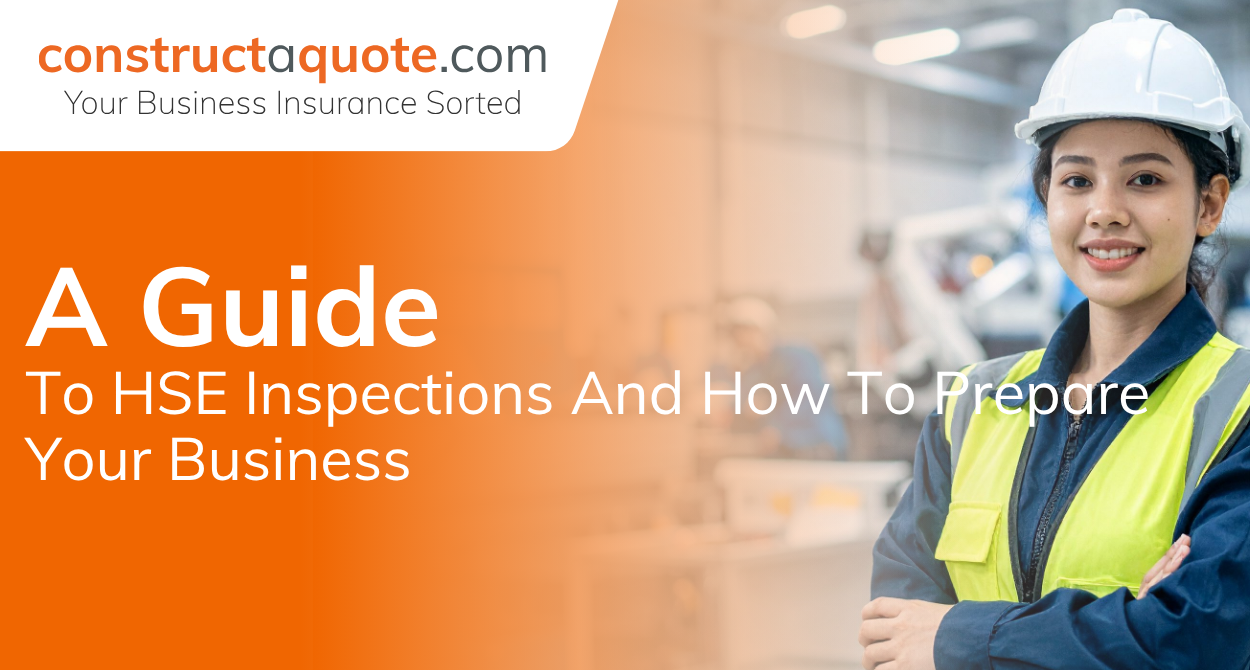by constructaquote - 31 July 2017


A HSE inspection is an inspection carried out by the Health and Safety Executive in order to prevent death, injury or ill health within the workplace.
The HSE regulator has been established for 40 years, and working together with the local authorities (LA’s) has resulted in the UK being one of the safest places in the world to work.
The purpose of the inspections are to reduce or even eliminate any risks to employees, customers or the general public within the workplace. Whether it’s hygiene, cleanliness or risk assessments, HSE inspections are there to protect the welfare of the public by identifying dangerous risks and encouraging the business owners to rectify the issues. Failing to do so can result in the business owner being fined and prosecuted and the business temporarily or indefinitely closed.
Health and safety inspections affect anyone that is in business, has duties under health and safety law (‘dutyholders’), is an employer to employees or in control of a workplace. Simply put, if you employ staff or have a workplace that is accessible to employees or the public, you are responsible for ensuring your business meets all of the required health and safety criteria.
It is the duty of the business owner to assess the health and safety risks within the business and comply to the current health and safety laws and prevent the risk of danger within the business.
Businesses that are high risk or manage food have to take extra precautions to ensure the correct levels of safety and hygiene are met.
Inspections can take place at random, however most businesses will be notified of an upcoming inspection. Inspectors have the right to enter and assess a property at any time.
Health and safety law is enforced by inspectors from the Health and Safety Executive (HSE) or by inspectors from your local authority.
Inspectors have the right to enter any workplace without giving notice, though notice may be given where the inspector thinks it is appropriate. On a normal inspection visit, an inspector would expect to look at the workplace, the work activities, your management of health and safety, and to check that you are complying with health and safety law. The inspector may offer guidance or advice to help you. They may also talk to employees and their representatives, take photographs and samples, serve improvement notices and take action if there is a risk to health and safety which needs to be dealt with immediately.
If an inspection has been carried out within the last three months, a further inspection will not be carried out. However, If the conditions of the workplace have seen substantial changes or if new information is published by the HSE, a representative is entitled to carry out another inspection before the three months have lapsed or if it is by agreement.
An inspector’s key role is to:
Inspections come in different forms and it is down to your HSE representative to agree on the most suitable method for your workplace. The main forms of inspection are listed below.
The frequency and way in which your workplace is scored by the heath and safety representative is dependent on the type of work and activities carried out within the workplace. Inspections will be carried out less, for example, if the work environment is low risk like in a predominantly administrative office. But if there are certain areas of a workplace or specific activities that are high risk or constantly changing, such as factories or construction, more frequent inspections are likely.
Post inspection, It is your duty to consider what appropriate follow-up action should be taken to anything that the health and safety representative has drawn to your attention.
On finding a breach of health and safety law, the inspector will decide what action to take. The action will depend on the nature of the breach, and will be based on the principles set out in HSE’s Enforcement Policy Statement. The inspector should provide employees or their representatives with information about any action taken, or anything that could affect their health, safety and welfare. Enforcement action can be delivered in several ways to deal with a breach of the law. In most cases these are:
It is the legal right of the dutyholder to appeal to an Industrial Tribunal should they feel their inspection was incorrect or unfair. This is offered to every dutyholder in writing at the time of an improvement or prohibition notice being served.
HSE operates a Fee for Intervention (FFI) cost recovery scheme. If you are breaking health and safety laws, HSE may recover its costs from you by charging a fee for the time and effort it spends on helping you to put the matter right, such as investigating and taking enforcement action.
Inspectors and local authority officers prioritise the highest risks and those businesses which fail to manage health and safety properly.
The key to ensuring you pass a health and safety inspection is to stay on top of the health and safety requirements at all time, not just when an inspection is due. Businesses that create a health and safety strategy and regularly assess the risks in their business and address them straight away, are more likely to pass an inspection.
For many businesses, all that’s required is a basic series of practical tasks that protect people from harm and at the same time protect the future success of the business
The approach you take should be proportionate to the size of your business and the nature of your business activity. For most small, low-risk businesses the steps you need to take are straightforward. If you have fewer than five employees you don’t have to write down your risk assessment or your health and safety policy
Here are some basic steps to consider when planning your health and safety strategy:
It is important to decide who is going to be responsible for overseeing the health and safety duties within your business. This must be a reliable person who takes their role seriously and has the necessary skills, knowledge and experience to manage health and safety.
For low risk- businesses, health and safety can be managed internally without having to hire expert help. This could either be an employee or the business owner/employer.
If you are a high-risk business, you may require external help and advice. It is important to make sure the right person is responsible for health and safety and is aware of the current laws to prevent an accident from happening and a potential prohibition or prosecution.
Planning your health and safety strategy and letting people know about how you plan to manage it will let your staff and others know about your commitment to health and safety. This is known as your health and safety policy and should clearly state who is responsible for what, when and how (the dutyholder).
If your business is smaller than 5 members of staff, there is no need to write down your health and safety policy.
The policy does not need to be complicated or time-consuming and should aim to be as simple as possible in order for everyone within the business to understand it.
Assessing the potential risks in your business is crucial to prevent them from happening. This is called a risk assessment and should be done by considering any possible danger, risk or accident that could occur. Consider what could cause harm to an employee, customer or member of the public and decide if you are taking the relevant steps to prevent that harm. If you are not, then this should be recorded as something you need to change immediately.
The purpose of the risk assessment is to highlight what is already being covered and what is not. It’s about identifying sensible measures to control the risks in your workplace.
A risk assessment doesn’t have to be a long-winded task that requires lots of writing, keep it simple and focus on the main risks.
The law does not expect you to remove all risks, but it does expect you to protect people by putting in place relevant measures to control those risks, providing they are reasonably practical.
For most low-risk businesses controlling risks is straightforward and there are many tools to guide you with your risk assessment on the .Gov website, like this one here: http://www.hse.gov.uk/risk/
Once you have identified the risks and what you need to do to prevent or control them, you then need to put the appropriate measures in place.
Many businesses change over time and bring in new equipment, products, substances or procedures which could lead to new hazards. Doing a regular risk assessment helps you to keep on top of any new hazards and how to prevent them.
When you have established all of the risks (if any) within the workplace, it is important to act on them accordingly and take the relevant steps to reduce the risks.
You also need address the following:
Find out more about Employers’ Liability Insurance and get a quote here.
For more information on health and safety, you can check out these Government resource pages:
http://www.hse.gov.uk/pubns/hsc14.pdf

by Charlotte Houghton - 7 October 2020
by constructaquote - 6 October 2020
by Charlotte Houghton - 29 September 2020
by Charlotte Houghton - 24 September 2020